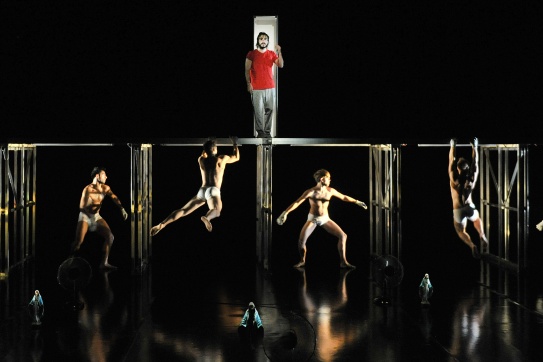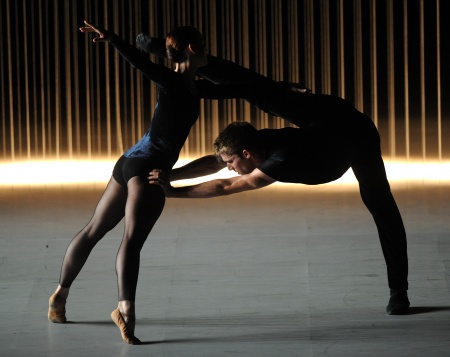 Dance Biennale in Lyon celebrated the 15th anniversary this year. Thirty years ago it was founded by Guy Darmet, trained lawyer and, most importantly, a big enthusiast – a “modern Diaghilev" in a sense, who created a dance platform for many dance artists. This important display of contemporary dance scene in France, but also from abroad belongs to the social and artistic milieu of Lyon. An inherent part of the Biennale today is a big dance parade bustling through the streets of this town. It is primarily an opportunity for amateur dancers of all ages to both present and entertain themselves as well as the city residents. This colourful and lively parade always has a theme in a similar way a festival has a dramaturgy. In 2010 the director Guy Darmet symbolically handed the festival management over to French choreographer Dominique Hervieu, who thus supervised and directed this year’s dance fair. Along with Mourad Merzouki she organized the Défilé de la danse (on 9th September 2012), and together they focused on the space "between heaven and earth."
As for the programme and production everything worked just fine. Most of the dancers and companies on the list were a prospect for a great event. However, as it soon turned out, the artistic level of this year's premieres deteriorated quite significantly. It is obvious that even the greats sometimes become somewhat worn out and nothing groundbreaking in their careers happens for some time. Anyway, this time it seemed to be a common state of things among all participants, which is in the case of the Lyon Biennale a somewhat alarming situation as there have always been performers so far who excelled and surprised the audiences. Thus the level of expectations as for ideas and overall quality was quite high.
Superfluous stylization by Angélin Préljocaj
Dance Biennale in Lyon celebrated the 15th anniversary this year. Thirty years ago it was founded by Guy Darmet, trained lawyer and, most importantly, a big enthusiast – a “modern Diaghilev" in a sense, who created a dance platform for many dance artists. This important display of contemporary dance scene in France, but also from abroad belongs to the social and artistic milieu of Lyon. An inherent part of the Biennale today is a big dance parade bustling through the streets of this town. It is primarily an opportunity for amateur dancers of all ages to both present and entertain themselves as well as the city residents. This colourful and lively parade always has a theme in a similar way a festival has a dramaturgy. In 2010 the director Guy Darmet symbolically handed the festival management over to French choreographer Dominique Hervieu, who thus supervised and directed this year’s dance fair. Along with Mourad Merzouki she organized the Défilé de la danse (on 9th September 2012), and together they focused on the space "between heaven and earth."
As for the programme and production everything worked just fine. Most of the dancers and companies on the list were a prospect for a great event. However, as it soon turned out, the artistic level of this year's premieres deteriorated quite significantly. It is obvious that even the greats sometimes become somewhat worn out and nothing groundbreaking in their careers happens for some time. Anyway, this time it seemed to be a common state of things among all participants, which is in the case of the Lyon Biennale a somewhat alarming situation as there have always been performers so far who excelled and surprised the audiences. Thus the level of expectations as for ideas and overall quality was quite high.
Superfluous stylization by Angélin Préljocaj
 Angélin Préljocaj is a French choreographer of Albanian origin, whose choice of material and its interpretation tends to suffer from occassional flips, but his artistic output has always been innovative. A premiere narrative piece Ce que j 'appelle oubli, inspired by the work of contemporary playwright Laurent Mauvignier, tells a story of an unfortunate and criminal incident. It was told and played on the stage by an actor and six dancers, who somewhat visualized individual situations and dramatic moments of the actual violent incident. A handful of men struggled with their own conscience. A superfluous stylization and unifying movement sequences confined dancers from their own dynamic interpretation. This time Préljocaj failed to surpass the literary source that overshadowed his choreography.
Magic of Philippe Découflé
Dance company DCA and its founder Philippe Decouflé are known most of all among the French. The sense of humour and gag and fondness for circus stunts of any kind are, above all, typically French. Anyway, the festival performance Panoráma was not a premiere in the true sense of the word, but rather a retrospective and a bit nostalgic recollection of the outstanding choreographies from the eighties and nineties. The audiences saw pieces of the famous fairy tale and kaleidoscopes of dance and circus art from the renown Codex, Decodex, Triton and, above all, from the memorable production Iris. Decouflé, a clown, artist, a superb choreographer and acrobat reviewed his work and with a new company of young dancers he brought on the stage magical dance whirls, fabulous shadow plays, visual and movie effects with dancers hanging in the air.
Tension of Maguy Marin and simplicity of Yuval Pick
Maguy Marin and her dance theatre never fail theatregoer’s expectations. Once again, a new production called Nocturnes brought about an inherent tension, however, nothing really new or different from her older works occurred there either. Light and darkness, light and darkness ... – these sudden changes and new and new images of life were created intentionally. It kept you wondering where you had seen or experienced them, even though you could not grasp the story line. Either way, you did not feel like trying to. It felt as if Maguy Marin took a book from her bookcase, opened it and then threw it away. And so it went on and you watched more and more outlined stories that were not danced in this case. They conveyed the excitements of a night street, chasing of Arabs or blacks. The girls were trying new clothes they had just bought, someone played the guitar and sang, lovers were impatiently waiting for each other, another person behind the door was having a dinner. Unfinished dramas flashed before your eyes and you knew Maguy was really good at this. Sometimes she can do it even much better, but she has also the right to play a little. She has left the CCN (National Choreographic Centre) in Rillieux la Pape and now enjoys the newly acquired freedom and creativity.
Last season she was succeeded by a gifted Israeli choreographer Yuval Pick. His naive, but clearly structured composition Folks is transparent in space, dynamics and time. A handful of dancers on the stage start in a circle. After some time simple dance steps and step sequences begin to multiply and both the quality of performance and demanding nature of partnering increase in all the solos, duets and trios. After an illusive end, or rather a dramatic twist we watch dancers carrying little trees, plants and flowers of all kinds from the backstage. Do they dance and move absolutely lightly and joyfully in an imaginary paradise? Pick through his straightforward work brought hope that there was beauty in simplicity and the hope for emerging talents.
Angélin Préljocaj is a French choreographer of Albanian origin, whose choice of material and its interpretation tends to suffer from occassional flips, but his artistic output has always been innovative. A premiere narrative piece Ce que j 'appelle oubli, inspired by the work of contemporary playwright Laurent Mauvignier, tells a story of an unfortunate and criminal incident. It was told and played on the stage by an actor and six dancers, who somewhat visualized individual situations and dramatic moments of the actual violent incident. A handful of men struggled with their own conscience. A superfluous stylization and unifying movement sequences confined dancers from their own dynamic interpretation. This time Préljocaj failed to surpass the literary source that overshadowed his choreography.
Magic of Philippe Découflé
Dance company DCA and its founder Philippe Decouflé are known most of all among the French. The sense of humour and gag and fondness for circus stunts of any kind are, above all, typically French. Anyway, the festival performance Panoráma was not a premiere in the true sense of the word, but rather a retrospective and a bit nostalgic recollection of the outstanding choreographies from the eighties and nineties. The audiences saw pieces of the famous fairy tale and kaleidoscopes of dance and circus art from the renown Codex, Decodex, Triton and, above all, from the memorable production Iris. Decouflé, a clown, artist, a superb choreographer and acrobat reviewed his work and with a new company of young dancers he brought on the stage magical dance whirls, fabulous shadow plays, visual and movie effects with dancers hanging in the air.
Tension of Maguy Marin and simplicity of Yuval Pick
Maguy Marin and her dance theatre never fail theatregoer’s expectations. Once again, a new production called Nocturnes brought about an inherent tension, however, nothing really new or different from her older works occurred there either. Light and darkness, light and darkness ... – these sudden changes and new and new images of life were created intentionally. It kept you wondering where you had seen or experienced them, even though you could not grasp the story line. Either way, you did not feel like trying to. It felt as if Maguy Marin took a book from her bookcase, opened it and then threw it away. And so it went on and you watched more and more outlined stories that were not danced in this case. They conveyed the excitements of a night street, chasing of Arabs or blacks. The girls were trying new clothes they had just bought, someone played the guitar and sang, lovers were impatiently waiting for each other, another person behind the door was having a dinner. Unfinished dramas flashed before your eyes and you knew Maguy was really good at this. Sometimes she can do it even much better, but she has also the right to play a little. She has left the CCN (National Choreographic Centre) in Rillieux la Pape and now enjoys the newly acquired freedom and creativity.
Last season she was succeeded by a gifted Israeli choreographer Yuval Pick. His naive, but clearly structured composition Folks is transparent in space, dynamics and time. A handful of dancers on the stage start in a circle. After some time simple dance steps and step sequences begin to multiply and both the quality of performance and demanding nature of partnering increase in all the solos, duets and trios. After an illusive end, or rather a dramatic twist we watch dancers carrying little trees, plants and flowers of all kinds from the backstage. Do they dance and move absolutely lightly and joyfully in an imaginary paradise? Pick through his straightforward work brought hope that there was beauty in simplicity and the hope for emerging talents.Artistry of Jiří Kylián Amazing Kylián's production One of a Kind, little known in the Czech Republic, is unique as a triptych. Its three parts are unified by the presence of a female dancer, who almost never leaves the stage. The uniqueness of a human being, the uniqueness of a moment and the celebration of freedom, all those themes are embedded in the subtext of the choreography. Jiří Kylián was commissioned to create this refined piece in 1998, the year marking the 150th anniversary of the Constitution of the Netherlands. Not all commissioned works of art are outstanding, in this case, however, a masterpiece has been created. Inherent dance qualities, excellent dance technique, beauty and perfection of movement result in a unique experience. The level of Lyon Opera Ballet company meets the high demands of the piece, but the performance of both casts on the premiere evenings was marked by a degree of apparent nervousness that somewhat suppressed Kylián's spirit and the performance thus lacked the authenticity and warmth of the original Dutch interpretation. Anyway, that might have been also due to the fact that the choreography is intentionally lit from below, which rather feels like watching a film footage.
Israel Galvan's Flamenco The most valued performance of the Biennale was La Curva by virtuoso dancer Israel Galvan, who has been continually, creatively and in a rather unique way transforming traditional flamenco to the level of contemporary theatre. Wherever he performs, he is called the "meteorite" of contemporary Spain. Along with the wide variety of performances, workshops and conferences daily screenings of dance films and theatre records have become another valued asset of the event, too. We could thus for instance recall Kazuo Ohno performing in his brilliant La Argentina and see something of the oeuvre of Ushio Amagatsu and his dancers from the Sankai Juku company, who performed at the Biennale too. Another outstanding movie was Monologue by the dancer Lisebeth Gruwez in the concept of Belgian Jan Fabre, which is one of his best and most frequently performed works.
Dance Biennale in Lyon, 13th - 30th September 2012 Translation by: Tomáš Valníček



Josef Bartos
Thank you for your thoughts. One got stuck in my mind – that passion makes us different from AI. Just yesterday I read…I am a dance critic. I am a member of an endangered species